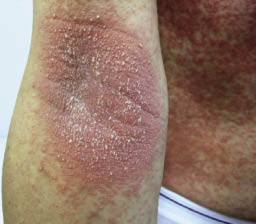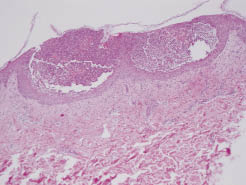Yoshitaka Nakamura, Akemi Takemoto and Masahiko Muto
Department of Dermatology, Yamaguchi University Graduate School of Medicine, 1-1-1 Minami-Kogushi, Ube, Japan. E-mail: k007um@yamaguchi-u.ac.jp
Accepted January 14, 2011.
Yoshitaka Nakamura, Akemi Takemoto and Masahiko Muto
Department of Dermatology, Yamaguchi University Graduate School of Medicine, 1-1-1 Minami-Kogushi, Ube, Japan. E-mail: k007um@yamaguchi-u.ac.jp
Accepted January 14, 2011.
Acute generalized exanthematous pustulosis (AGEP) is a disease characterized by the rapid onset of numerous small, non-follicular, sterile pustules on an erythematous base associated with oedema, which usually begins in intertriginous areas (1). Fever over 38ºC and peripheral blood leukocytosis are often present in these patients. AGEP is usually attributed to systemic drugs, mainly antibiotics. Sidoroff et al. (2) proposed a validation score based on morphological and histological criteria as well as on the disease course.
Etodolac, a non-steroidal anti-inflammatory drug (NSAID) with potent cyclo-oxygenase type 2 (COX-2) inhibition, is widely used in the treatment of patients with osteoarthritis due to a more favourable therapeutic index compared with other NSAIDs. We report here a case of AGEP caused by etodolac in a 70-year-old Japanese man, which was confirmed by the lymphocyte transformation test (LTT) in vitro. Although there have been previous reports of AGEP induced by selective COX-2 inhibitors (3–7), to the best of our knowledge, this is the first case of AGEP caused by etodolac.
CASE REPORT
A 70-year-old Japanese man was admitted with a generalized eruption. One week prior to admission, he was prescribed etodolac, 400 mg/day, for right lower back pain. Five days after starting etodolac, he developed a fever and erythematous papules and pustules on the back of the neck and both antecubital fossae, which spread to his extremities and trunk over 2 days (Fig. 1). He had not taken etodolac previously and had no history of adverse reactions to other drugs. He had no history of psoriasis.

Fig. 1. Erythematous eruption with a diffuse distribution of non-follicular pustules in both antecubital fossae.
On physical examination, an erythematous eruption, characterized by a diffuse distribution of non-follicular pustules, was seen on his extremities and trunk, which was prominent in both antecubital fossae. Mucosal involvement was not observed. Bacterial and fungal cultures of the pustular material were negative. His temperature was 38.8ºC and laboratory examination revealed an elevation of C-reactive protein (11.2 mg/dl, normal < 0.2 mg/dl) and an increased number of white blood cells (21,160 cells/mm3; normal 4,000–10,000) with increased neutrophils (18,303 cells/mm3; normal 1,600–6,000).
The histopathology of a skin biopsy from the right antecubital fossae revealed subcorneal spongiform pustules, necrotic keratinocytes, papillary oedema, and polymorphous perivascular infiltrate with neutrophils, consistent with the histological appearance of AGEP (Fig. 2).

Fig. 2. Subcorneal spongiform pustules with necrotic keratinocytes and polymorphous perivascular infiltrate with neutrophils. Haematoxylin × 16.
Although the eruption resolved with desquamation within 7 days after cessation of etodolac along with treatment with 0.05% difluprednate ointment and oral prednisolone, 30 mg/day, the high fever and right lower back pain persisted. Computed tomography (CT) revealed a swelling in the right iliopsoas muscle and probable fluid collection, consistent with an intramuscular abscess. Magnetic resonance imaging confirmed the diagnosis of an iliopsoas muscle abscess associated with pyogenic spondylitis of L3/4. CT-guided percutaneous drainage removed 60 ml of purulent fluid and bacterial culture yielded Streptococcus intermedius. We therefore stopped oral prednisolone and started intravenous meropenem. The patient’s fever and right lower back pain began to subside after the commencement of antibiotic treatment, and the eruption did not recur after withdrawal of prednisolone.
Patch-testing, performed on the involved skin with 1% etodolac in petrolatum, one month later was negative at 48 h and 72 h. We therefore performed the LTT using six different concentrations (0.26, 1.28, 6.4, 32, 160 and 800 μg/ml) of etodolac in triplicate. The LTT was positive, with a stimulation index (SI) of 2.3 (> 2.0 being regarded as positive) using a concentration of 6.4 μg/ml of etodolac. From this, we diagnosed the eruption as AGEP caused by etodolac.
DISCUSSION
AGEP is considered to be a clinical reaction pattern, which is caused by systemic drugs, mainly antibiotics, in over 90% of cases. Although, in rare cases, AGEP has been associated with infectious diseases, particularly viruses, it is uncertain in this case whether the iliopsoas muscle abscess was related to the AGEP. However, the administration of oral prednisolone may have worsened the iliopsoas muscle abscess associated with pyogenic spondylitis.
Our patient had typical features of drug-induced AGEP, including a characteristic clinical course, morphology and histology. According to the proposed AGEP validation scoring system (2), the total score in this case was 12, suggesting a definitive diagnosis of AGEP.
Patch-testing has been useful in identifying the causative drugs in cases of AGEP, but only 50% of AGEP cases demonstrate positive patch-test results (8). In general, LTT demonstrates a high SI towards causative drugs in AGEP, suggesting that drug-specific T cells mediate AGEP (9). Although the patch-test was negative in our patient, the clinical and histological findings, as well as a positive LTT suggest that etodolac induced AGEP.
Etodolac, a pyranocarboxylic acid, is a potent COX-2 inhibitor that inhibits the formation of prostaglandin endoperoxides from arachidonic acid. AGEP caused by selective COX-2 inhibitors, such as celecoxib, valdecoxib, etoricoxib and nimesulide, has been reported previously (3–7). Our case suggests that, in addition to other COX-2 inhibitors, etodolac may cause AGEP.
REFERENCES
